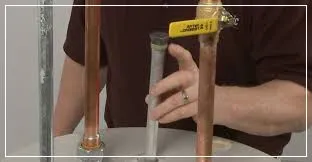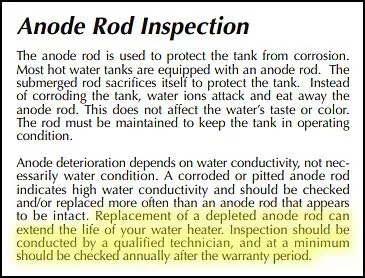
Fortunately, there are many things you can do to prevent such catastrophes from happening. If you are regularly monitoring and maintaining your system, you can watch for trouble and hopefully prevent system failures.
We all know what happens if a car is scratched or damaged and water, road salt, and other corrosives are able to get at the steel frame: it starts to rust and break down. Your water heater, made of steel and lined with vitreous glass, could follow a similar path if damaged or unmaintained. Fortunately, your water heater is equipped with a part to help withstand corrosion. The anode rod, sometimes called the sacrificial anode rod, is crucial to the prevention of water heater failure. The anode rod is designed to attract the corrosive material in your water so that it will corrode before your water heater will. This is why it’s called sacrificial; its demise means your tank is spared. However, because the anode rod’s job is to corrode, it must be checked often to make sure it’s still protecting your tank.
These instructions are designed to help the do-it-yourself homeowner take care of their own water heater. However, if you read the following instructions and feel like this might be a bigger job than you want to take on, call a plumber you trust to help.
Before performing ANY maintenance on your water heater, complete the following 4 steps FIRST to avoid the risk of water damage, scalding burns, electrocution, or explosion:
First, you’ll need to attach a garden hose to the spigot at the bottom of the water heater. Make sure to direct the hose to a drain and be aware that the water coming out will be VERY hot. Open the spigot and drain a little water to relieve some pressure and heat inside the tank before opening the top for the anode rod.
Next, go to the top of your water heater and look for a hex head bolt. If you don’t see the hex head, it’s likely built into your water heater system. If the anode rod is built into the system, checking or replacing it will require the assistance of a licensed plumber. Keep in mind you also may need to pry open one of the plastic caps on the top of the tank with a flathead screwdriver to find it. Fit a 1 1/16-inch socket onto the rod's hex head on top of the heater (or under its top plate) and unscrew the rod. Pull the rod out of your water heater and remember to use caution because it’s probably very hot.

